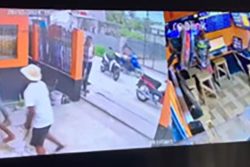Dear Editor,
VP Jagdeo must be applauded for accepting that corruption exists in public procurements. He stated that the Guyana Government plans to strengthen the tender and procurement system by a prequalifying system for contractors. The National Procurement & Tender Adminis-tration Board (NPTAB) “Guide to the Public Procurement Procedures” already has the requirements and procedures for prequalification of contractors (SECTION 3 Public Procurement Methods and Strategies Part 7 Competitive Tendering and Award Procedures). These are consistent with international practice.
There are two approaches to finding a workable solution to the current corrupt practices (abuse of power and unethical behaviour for personal gain) in public procurement. One approach is window dressing with cosmetic changes to appease the public. The other approach is comprehensive and requires (1) accepting that the problem exists, which VP Jagdeo did, (2) getting a clear understanding of the problem and its fundamental causes, (3) developing possible solutions considering the context, (4) applying the best possible solution, (5) monitoring the effectiveness of the solution and making changes as required, and (6) employing efficient and effective enforcement.
The writer wrote (SN, May 3, 2024) that “Over several decades, Guyanese have suffered from corruption in Government services and projects. Corruption has become, justifiably, a Guyanese state of mind. Successfully transforming Guyana also requires transcending the society.” But transcending a democratic society that has a rotten, corrupt system fermented to an endemic level for over 50 years will take an exceptionally long time. The first step is to start with the political class and then working toward the public. Political interference and preference, a facet of public procurement worldwide, is often shrouded in secrecy with persistent allegations of corruption. The public must experience accountability for corrupt practices by public officials within a legal system that is expeditious and fair. Cases of alleged corruption by politicians are languishing in Guyana’s judicial system. The public has grown accustomed to unaccountability from unethical practices. They have acquiesced to corruption as normal in obtaining services, especially Government services.
From a quick review of the Audi-tor General (AG) annual reports, one can easily discern a plethora of corrupt practices, the flaunting of the extant rules and procedures in tendering and procurement, poor or absent project management and inferior quality control. Recent News Media (NM) reporting from statements made by the public and Government officials indicate that corrupt practices and transgressions continue to flourish without penalties. For this article’s purpose, the process for procurement and execution of public works are planning, design, tendering, bid evaluation, contract award, and construction. Each of these can be exploited by unscrupulous personnel for personal gain. For example, let us consider design, which is the technical, professional work of designing, preparing construction drawings and specifications, cost estimation, special contract requirements, desired contractor’s qualifications and experience. One can discover from the AG annual reports and NM reports that some corrupt practices arose from below reasonable standards of professional care, overpricing/underpricing, inflated/deflated tender prices, poor and non-standard drawings and specifications, reduced contractor’s qualifications and experiences, possible disclosure of cost estimates, engineers colluding with potential contractors, lack of knowledge about professional code of conduct, no professional bodies for registration, certification and compliance monitoring, absence of building codes and standards.
Bid evaluation and construction are two prominent layers in public procurement and execution of public works that are prone to corrupt practice not only in Guyana but worldwide. According to NPTAB, bids are evaluated by a “Bid Evaluation Committee of three qualified members drawn from the pool of evaluators if one has been prepared, preferably persons who participated in the preparation of bidding documents.” The latter could have prepared key parts of the bidding documents such as cost estimates, required contractor’s qualifications and experience favourable to a particular contractor. The AG annual reports and NM reports show cases of incompetent contractors, some with no relevant qualifications and experience for the project. Bid amounts and engineering estimates appearing in NM reports suggest complicity between contractors and Government staff.
A typical construction phase includes the contractor preparing construction management documents detailing the sequential construction processes and activities, material sourcing, delivery, storage, safety, duration, responsible personnel for each activity, dependencies, milestones, and payments. The client, in this case the Guyana Government, must have qualified, experience project managers to review the contractor’s construction management documents, monitor construction, conduct quality control tests, and to authorize or stop payments. From the AG annual reports and NM reports, except for large projects, project management on behalf of the public is poor/or absent. Very few contractors, if any, are required to produce these construction project management documents. The AG annual reports are littered with contractors’ defaults from not starting a project, although receiving some payments, to poor quality work and inferior substituted materials. There are reports of Government technical personnel ignoring these defaults for kickbacks. Many contractors are working without engineering drawings and specifications. Some cannot read an engineering drawing. Issues with contractors resulting from unethical practices and non-compliance with the NPTAB process seem more acute in works authorized by NDCs.
No country is immune from corrupt practices in public procurement of goods and services. The most challenging aspect of corruption prevention is ethical compliance resulting from individual greed, engineering, and construction professionals unaware of and/or follow professional code of conduct, and normalization of corruption in society. It is incumbent, giving the rapid pace of infrastructure development without the capacity in the required skill sets, to conduct a comprehensive review of the applications of the extant NPTAB rules, revise them, if needed, and develop, implement, and enforce appropriate measures to reduce incidences of corruption. External (independent) peer review of design documents, specifications, and contracts, bid evaluation, construction management documents, safety measures, monitoring and quality control tests, and payment schedules can eliminate incidences of corruption. Digital technologies such as e-tendering and e-procurement systems with compliance checking, Generative AI (GenAI) for procurement, project and construction management software tools, continuous procurement and construction data gathering and analyses will also impede corruption. Control of corruption must include code of conduct and ethics training, contractor’s certification, and accountability.
Any effective anti-corruption solution requires political stability, political will, high ethical standards, national engagement, and patience. The enforcement of NPTAB rules and procedures is crucial for Guyanese to receive value from public expenditures. It is encouraging that VP Jagdeo plans to tackle the monumental task of addressing corruption in public tendering and procurement. The public should look forward to the beginning of a comprehensive rather than a window-dressing approach.
Sincerely,
Dr. Muniram Budhu
Professor Emeritus





